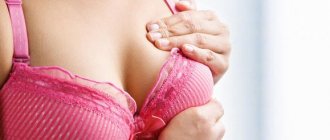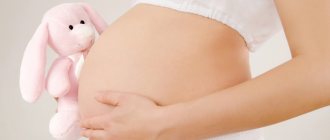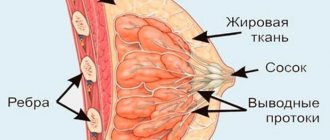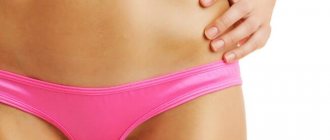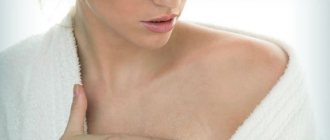Menstrual discharge is often accompanied by breast swelling and tenderness. This is due to increased estrogen production. This hormone prepares the body for a possible pregnancy. It is localized in adipose tissue, its increased formation leads to an increase in the volume of those organs where adipose tissue is present. The breasts increase in size and blood flow becomes difficult. The result of impaired blood flow is swelling, soreness and heaviness of the mammary gland.
Breast swelling and tenderness can occur during ovulation (days 12–14 of the cycle), occur a few days before the start of menstruation and usually go away after their completion. Sometimes breast swelling goes away immediately after your period starts. Doctors confirm that between periods, not counting a few days of ovulation, the breasts should not hurt or become full. If the body is physiologically healthy and conception has not occurred.
If the breast continues to hurt after menstruation, the heaviness of the gland and the increased density of adipose tissue remain, this indicates an increased level of estrogen in the blood.
In what situations does this happen?
Causes of pain before menstruation
According to statistics, 9 out of 10 women experience pain during this period. Characterized by breast swelling, enlargement, a feeling of heaviness and puffiness.
In addition, this condition indicates that a woman of childbearing age is ready for lactation, so most often the pain occurs before ovulation, somewhere on the 12-14th day of the cycle. This is due to the fact that during this period the production of estrogen is increased.
These female hormones are localized in adipose tissue, which is why:
- The breasts are temporarily enlarged;
- Becomes denser;
- Blood circulation in it becomes difficult;
- Tissue swelling appears;
- Then pain occurs.
They can be expressed in different ways, depending on many factors:
- age;
- physical health;
- lifestyle and so on.
The main characteristics of the manifestation of painful sensations are as follows:
- A week or two before the onset of menstruation, the breasts slightly increase in size, begin to hurt, and you feel their swelling and heaviness in the mammary glands;
- There may be just tingling sensations without pronounced pain, but it becomes denser;
- Some women complain of nipple pain. This is caused by increased blood flow and also refers to the manifestation of the menstrual cycle;
- Chest pain may be accompanied by nagging and aching pain in the abdominal area. Most often, the condition worsens a couple of days before the onset of menstruation.
Nipple discharge
Discharge from the nipples can occur due to pathological abnormalities or during normal cyclic processes.
Experts say that discharge can only occur during pregnancy. In all other cases, it is worth finding out the reason. Discharge from the breast, except during the lactation period, may appear in the following situations :
- With strong sexual arousal during the period of stimulation of the areola area.
- A few drops of light liquid may come out if you press on the nipple before menstruation. At this point, a burning sensation may appear in the chest.
If the fluid released from the breast is not milk, then it is considered abnormal discharge. At the appointment, the mammologist is obliged to clarify the exact consistency and color of this discharge.
If, when squeezing the nipple, a thick, brown, slightly sticky liquid is released, or the discharge has a greenish tint, then ectasia of the milk ducts is considered a possible cause. It is observed in women during menopause.
If the discharge has a brown color, which ranges from light to dark, then this may indicate intraductal papilloma. She needs rapid diagnosis and treatment.
If purulent, scanty discharge from the mammary gland appears, which has an unpleasant odor and occurs during breastfeeding, this may be mastitis. In this case, only one mammary gland hurts. Her skin will be hot to the touch
How to alleviate the pain?
Very often, the discomfort caused by the premenstrual state prevents you from leading a normal lifestyle these days.
But there are several common methods to reduce the symptoms of PMS:
- A heating pad with warm water. It is placed on the abdominal area;
- Warm bath (not hot);
- Diet. It is recommended to exclude natural coffee, black tea, as well as salty and spicy foods from the diet. It is better to drink natural juices and eat more vegetables;
- Magnesium supplements. They begin to be taken in the second phase of the cycle;
- Avoid hypothermia;
- Stress. This factor affects hormonal balance. You should be less nervous, drink soothing teas;
- Excessive pain may be a deviation from the norm, so you should consult a specialist for advice.
How to overcome pain
Painful sensations in the chest are normal, but the condition can be significantly alleviated if you follow the rules. The skin needs to breathe, so you need to shower regularly. Linen must be made from natural materials.
There are special bras for pregnant women. These bras have wide straps that hold the cups, they do not rub the skin, there are no protruding bones, seams or decorative elements. They are worn during the day, at night the breasts should rest and breathe, so it is better not to wear a bra at night.
If your nipples hurt, breast massage helps. Massaging movements should not be too intense. To carry out the procedure, you can use baby oil. After the massage you will need to take a shower.
Why do my breasts hurt during my period?
It takes time for the glandular tissue, which has grown before menstruation, to return to its normal state. These times are the days during menstruation. Most often, by the end of the treatment, the pain disappears.
But still, this symptom can be concomitant with a number of diseases:
- Gynecology. Very often, pathologies in this area are characterized by pain in the mammary glands;
- Hormonal imbalance. This phenomenon does not necessarily apply to gynecology, but must be investigated by a specialist.
What to do if you have breast pain
If breast soreness after menstruation is physiological, that is, the mammary glands hurt either a young girl or a pregnant woman, you can use the same means to alleviate pain as during menstruation:
- choose a bra according to size;
- take a warm bath or shower;
- review your diet;
- reduce smoking.
If the pain does not go away for a long time, you can use non-steroidal painkillers, but you need to select them together with your doctor.
Pain at different times of the cycle
If the feeling of discomfort in the mammary glands does not stop, then:
- There is a high probability of pregnancy, which is accompanied by the active production of female hormones, which are responsible, among other things, for the condition of the breasts;
- Muscle strain or inflammation;
- Delayed menstruation, which is possible with a cold or hypothermia.
At the same time, such symptoms may be a cause for concern and a visit to the doctor, because this deviation may be a sign of a serious illness, namely:
- Ectopic pregnancy;
- Breast cancer;
- Inflammatory or infectious processes in the mammary glands;
- Mastopathy is a benign neoplasm that, without treatment, can lead to the development of cancer.
Pregnancy
If a week after your period your breasts begin to hurt, then you may be pregnant. The fact is that 16% of women continue to have periods after pregnancy. Typically, menstruation can occur 1-3 times, and the woman does not realize that she is pregnant.
Despite this, the body begins to actively prepare for the birth of a child. There is an increased increase in estrogen and progesterone. The breasts increase in size, swell, and prepare to produce milk.
The danger of chest pain
Discomfort may not be associated with PMS and may indicate the presence of diseases. It is recommended to undergo a medical examination to exclude a number of serious pathologies:
- Disorders in the field of gynecology;
- Ovarian dysfunction;
- Malfunctions of the thyroid gland, liver and other organs;
- Mastopathy.
That is why every woman should undergo a preventive examination at least once a year by an endocrinologist, mammologist and endocrinologist. Specialists may prescribe laboratory tests for tumor markers or hormones, breast ultrasound or pelvic ultrasound.
Examination by a gynecologist and principles of treatment
The main rule of therapy is timely consultation with a doctor. The purpose depends on the cause that provoked the appearance of the symptom.
If unpleasant sensations occur regularly, experts recommend keeping records with the dates of spasm occurrence, levels of its severity, duration and accompanying symptoms. Such a diary will help reproduce the full picture of the pathological sign at a doctor’s appointment.
Usually, a trip to the gynecologist begins by asking the patient about the nature of the pain. Then the doctor palpates the mammary glands and armpits to identify unnatural deformations and seals. If there are any, the woman is sent for a mammogram or ultrasound examination, and is also asked to undergo tests.
Benign tumors are removed surgically. Single small cysts cannot be removed, but are observed. Malignant tumors undergo chemotherapy.
Mastopathy is treated with special medications in the form of tablets and hormone-containing ointments.
How to examine your breasts
Women who experience breast pain after menstruation should see a specialist. The examination is carried out in several stages:
- Initially, the breasts are examined at home;
- after palpation is performed by a specialist;
- The final stage of diagnosis is a mammogram.
Twice a year, a woman, regardless of the presence or absence of abnormalities, should visit a therapist. From the age of 35, it is recommended to undergo a mammogram once every calendar year to exclude the development of diseases that precede breast cancer. The examination makes it possible to identify any changes and their nature.
Necessary diagnostic measures
If you cannot determine the exact cause of chest pain yourself, then you should consult a doctor. Especially if alarming symptoms arise and your stomach and chest hurt after your period. These signs may indicate serious pathological problems.
To conduct a complete diagnosis, it is necessary to undergo a number of such studies:
- Mammography is a modern method of research using laser illumination of breast tissue;
- Ultrasound examination, not only the mammary glands are visible, but also the lymph nodes near them;
- ductography, this method is used as an auxiliary method; it is used to study structural changes in tissues;
- a puncture is used when a formation is detected, the contents are sent for a biopsy to determine the nature.
Breast examination by age
To prevent pathological changes in tissues, a woman should undergo a gynecological examination annually. Also, if symptoms of breast ailments occur after menstruation, it is recommended to make an appointment with a mammologist.
Basic diagnostic measures:
- Mammography.
- Pneumocystography.
- Needle biopsy.
- Ultrasonography.
- Ductography.
If, as a result of these studies, the doctor does not identify a pathology, then the discomfort has a physiological etymology. Otherwise, you need to undergo appropriate therapy.
How to conduct a self-examination of the mammary glands?
It is extremely important for every woman to perform a breast self-examination after her period, around days 7-11. This will help to identify fibrocystic mastopathy at the initial stage of development, breast cysts, and also detect tumor formations in the breast in the early stages.
The breast self-examination algorithm is as follows:
- Stand near the mirror and examine your breasts: you should look at the shape of the breasts, the color of the skin of the nipples, your arms should be lowered during the examination.
- Raise both hands behind your head and examine your chest while in this position. Determine if there is a change in the shape or size of one of the mammary glands, pay attention to the color of the skin.
- The right hand must be thrown behind the head. Then, with slow, smooth, massage circular movements, palpate the right mammary gland, paying special attention to compactions, swelling and thickening. The same steps should be repeated with the left breast.
- Using the thumb and index finger of one hand, apply gentle pressure to the base of the nipple and look for any discharge from the nipple. Do similar actions with both the left and right mammary glands.
- Take a supine position. Using circular movements, applying light pressure, you need to feel the breasts, starting from the edges of the mammary gland towards the nipples.
- Using light circular movements, you should palpate the left and right armpits, paying attention to the presence of enlarged lymph nodes. If any, you should consult a specialist.
Why do my breasts hurt after menstruation?
As mentioned above, there may be several reasons:
- Pregnancy;
- Hormonal disbalance;
- Mastopathy;
- Osteochondritis.
If a woman is sure that she is not pregnant, then she should consult a mammologist.
Chest pain is divided into cyclical and non-cyclical. Non-cyclic may come from organs close to the mammary glands. This type also includes pain that occurs at different times of the cycle, which worsens and subsides. Cyclic directly depends on menstruation.
It is necessary to take non-cyclical pain especially seriously, because they can be signs of a tumor or osteochondritis, a type of arthritis (the source of inflammation is located at the junction of the ribs and sternum).
Hormonal disbalance
With normal hormonal background, breast swelling goes away after the start of menstruation. If your period has passed and your breasts still hurt, there may be a hormonal imbalance. Possible hormonal disorders within the female body can be caused by the following factors:
- use of hormonal drugs (contraceptives);
- the appearance and growth of tumors (especially if these are tumors in the upper part of the body, the chest will react sensitively to the adjacent lesion and hurt);
- age (chest hurts during menopause);
- sexually transmitted infections (chest pain due to syphilis);
- infection of the mammary gland and its inflammation;
- parasitic infestations;
- stress and anxiety (the chest may hurt due to nervous disorders);
- heredity.

